How Long Does It Take For A Pearl To Form
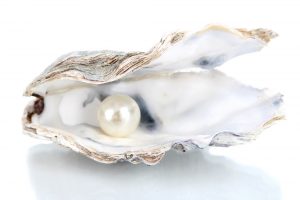 Pearls are so beautiful and sparkle and the only gemstone in the whole world that comes from a living creature. Even though most of the pearls we have in the market are not naturally made, they completely look like the real ones. Did you ever wonder how long does it take for a pearl to form in the oyster, clams, or mussels?
Pearls are so beautiful and sparkle and the only gemstone in the whole world that comes from a living creature. Even though most of the pearls we have in the market are not naturally made, they completely look like the real ones. Did you ever wonder how long does it take for a pearl to form in the oyster, clams, or mussels?
They take a couple of years to form pearls inside them; even forming pearls in a mechanical way requires a lot of time. But the more time they take, the more good quality pearls those creatures can supply.
Here in this article, we will discuss pearls, such as how they are made and how long they take to form.
Read also: How Much Is A Black Pearl Worth
Do All Oysters Have Pearls?
An oyster, clams, and mussels can naturally produce pearls inside them. Even though they are different from each other in some spices. There is a mollusk inside them which actually is responsible for creating pearls.
Not all the oysters include pearls in them; mostly, the bigger oysters have pearls as they are older and had enough time to form a pearl. Basically, there is no official sign that can determine whether the oyster has pearl or not; the only way to know it is to open an oyster to see. It’s a bit rare to find pearls in every oyster you collected.
How Rare is It to Find a Pearl in an Oyster?
Finding natural pearls is very rare; even if you collect thousands of oysters, only one of them will have pearls. So most of the pearls that you see in jewelry are not real, and those pearls are created by humans. Natural pearls don’t require any human intervention to form, and they are super rare. The cultural pearls take a few years to be made by humans.
How Are Pearls Made?
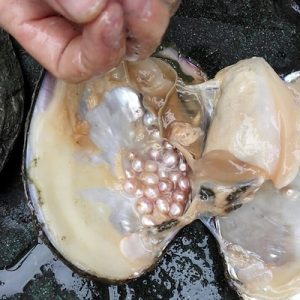 Pearls can be found naturally inside an oyster, or you can find cultural or farmed pearls. Natural pearls are generally formed inside oysters, clams, or mussels, and they are small objects. White, gray, and cream colors are common and mostly found in natural pearls.
Pearls can be found naturally inside an oyster, or you can find cultural or farmed pearls. Natural pearls are generally formed inside oysters, clams, or mussels, and they are small objects. White, gray, and cream colors are common and mostly found in natural pearls.
Another way of forming pearls is nacre; the oyster will coat layer by layer with fluid. As time will pass by, the layers of nacre build-up, and then a pearl creates inside the oyster. The process of creating pearls is long and takes a couple of years to build up.
The growth of the pearl in the nacre method depends on the type of pearl. Akoya pearls have a growth of 0.3 mm per year, Tahitian and Australian south sea pearls have a growth of 2 mm per year. The Chinese freshwater pearls can grow around 5 mm per year.
And the cultured pearls also form pearls in the same way as nacre pearls. But in this process, the farmer implants mantle tissue, shell, or bead inside the oyster with concern. The bead they use to form a pearl is known as the Mother of Pearl.
The common shape of freshwater pearl and saltwater pearl is round, but you will also find peals of various shapes. All the different shaped and colored pearls are more expensive than the usual pearls.
How Are Pearls Harvested?
The procedure of forming a pearl by yourself is a bit complicated and complex, and also it requires a lot of time, but the final result is satisfying. All those sparkling pearls were harvested by implanting mantle tissue inside an oyster very carefully. Farmers who harvest the pearls may also use beads to form a pearl in freshwater.
Then the procedure of nacre starts within 3 to 4 months. The speed of the nacre procedure varies for the mollusk the oyster has, and mollusk is the main thing that makes the material of the pearl. Temperature and the water type are other important factors for the nacre speed.
The farmer has to check the pearl regularly to inspect the sickness, environment of the water, food quality of the oyster, and more. The oyster will not die when they harvest the pear as the farmers perform the implantation process with lots of concern.
How Long to Form Cultured Pearl?
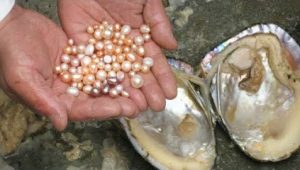 Akoya pearls are collected for harvest after a year, and Tahitian and South Sea pearls are collected after 2 to 4 years for harvesting. The Edison freshwater pearls are usually harvested after 2 to 7 years. There are a few factors, and the type of pearls is responsible for different rates of pearl growth.
Akoya pearls are collected for harvest after a year, and Tahitian and South Sea pearls are collected after 2 to 4 years for harvesting. The Edison freshwater pearls are usually harvested after 2 to 7 years. There are a few factors, and the type of pearls is responsible for different rates of pearl growth.
Akoya pearls can grow into 9 mm size after 14 months in diameter. Tahitian pearls can grow 10 mm in 2 years, while South Sea pearls take three years to form in 15 mm. The more time you will give the oyster to form the pearl, the better and good quality pearl you will receive.
If you let the oyster or mussels take a few years to create the pearl, that pearl will last longer than around 50 years. And the pearls which are quickly cultured can last for a few years as they are low-quality pearls; thus, they wear out too fast.
In today’s world, China is the country where pearls are produced on a large scale in freshwater. The average number of pearls produced is more than 1500 metric tons per year.
How Much Are Pearls Worth?
Basically, round pearls that are collected from freshwater costs around $60 to $2000, depending on the quality. Akoya pearls are a bit expensive, and they are ranging around $300 to $10,000. But there are few factors that determine the cost of cultured pearls, such as their quality. 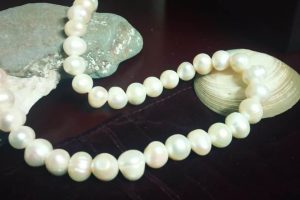
Here are six different quality factor of cultured pearls:
- The thicker and smoother the nacre pearls are, the higher it costs.
- The more sparkle luster pearls are, the more valuable they are.
- The cleaner is the surface of the pearls; it will cost high.
- Shapes also determine the prices like the round, and even pearls are more valuable as they are more demanding.
- The colors of the pears are also a factor; the more popular the colors are, the more value it includes.
The price of the pearls also depends on how they were created:
- Wild vs. Cultured pearls: Wild pearls are more valuable than cultured pearls.
- Freshwater vs. Saltwater: Saltwater pearls are more expensive than freshwater pearls.
You will also find another type of pearls called seed; these are more expensive than other pearls. Seed pearls are small in size, and they are natural pearls; they usually form in freshwater mussels, even in saltwater oysters. They are less than 2mm in diameter, which makes it hard to stand over a jewelry piece.
Are Freshwater and Saltwater Pearls Worth the Same?
No, basically they have different prices and are not worth the same. Saltwater pearls are more expensive than freshwater pearls as forming pearls in saltwater is hundred times harder than the other one. Besides, they can only form 2 to 3 pearls in one oyster. On the other hand, freshwater pearls in mussels can grow more than 32 pearls per shell. Thus, the worth of the pearls from two different waters ranges differently.
What are the types of pearls?
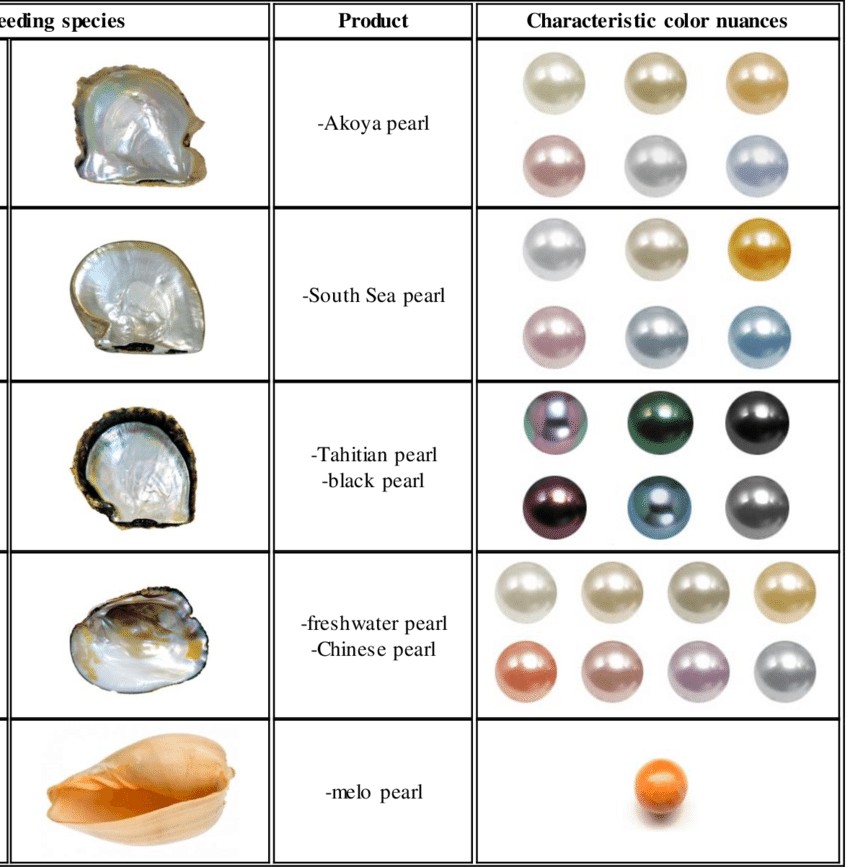
You have already learned about two different types of pearls from the above discussion, and they are freshwater pearls and saltwater pearls. Here is the other way to identify the pearl types:
Natural Pearls
Natural pearls basically come from the wild harvest. There are few reasons that determine why they are extremely rare. One oyster outer ten thousand oysters can form a pearl inside the wild. Thus till now, so many types of mollusks have been found and collected that have clear the history of pearls significantly. In the current market, it’s very rare to find a natural pearl that was collected from real oysters, and even if you found one, it will cost too high.
Cultured Pearls
Near 1893, there was a person named Kokichi Mokimoto who tried twenty years to form a pearl in a cultural way. And then, after nearly twenty years of trying, he finally achieved a cultural pearl. What he did was put a nucleus inside the oyster carefully, and it helped to transfer the creature into covering the nucleus. He took the help of nacre layers while doing the process. And now, almost all the pearls available in the market are cultured pearls. You can find different colors, shapes, and luster depending on the region.
Frequently Asked Question (FAQ)
How long does it take for a pearl to form naturally?
The real pearls inside the oyster take around six months to form naturally. But they almost take a year to grow in a decent size and shape. Framers can collect pearls after a year to harvest them and make pearls inside the oyster by implanting mantle tissues. So the more time they give the pearl to form, the great quality and large pearls they can have.
Does the oyster die when the pearl is removed?
No, the oyster will never die by only removing or collecting the pearl from them. Farmers who harvest oysters are very careful while implanting the tissue and beads so that the oyster doesn't die. In fact, they use surgical-style instruments to not harm the oysters. The older the oysters are, the better and more pearls they produce.
How much is a real pearl worth?
The real pearls are the rarest, as one oyster out of thousands can give decent pearls. Again the shape, color, and size of the pearls are factors that determine the worth of a real pearl. However, the real pearls are worth around $300 to $1500.
Final Thoughts
So you have just gone through the in-depth information on how long does it take for a pearl to form in different ways. You also get to learn how natural and cultured pearls actually form and how much time they take. Freshwater pearls are widely used in the market as they are less expensive and don’t require much effort to form pearls in freshwater.
Finding a few natural pearls is extremely challenging, let alone using natural pearls in jewelry. Still, you can find jewelers that are made with good quality and thick cultured pearls.
